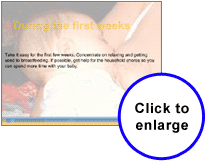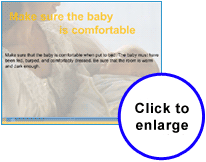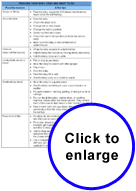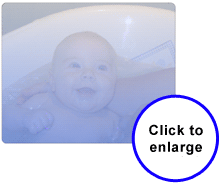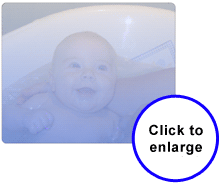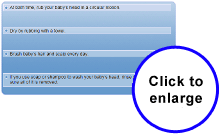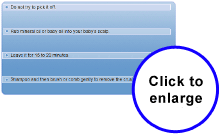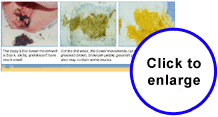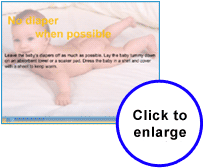B. BABY CARE
Caring for an infant requires skill and practice. No one is born knowing how to bathe, dress, feed, and diaper a baby. Most parents learn these skills as their baby grows.
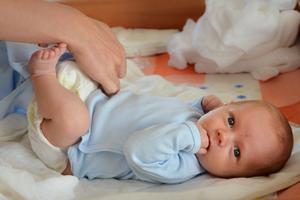
Don't worry if you feel awkward and uncertain at first. In no time, looking after your baby will feel natural.
a. Breastfeeding
Breast milk is the perfect food for your baby. You will find all the information you need to successfully breastfeed your baby in Module 4 entitled "Choosing to Breastfeed".
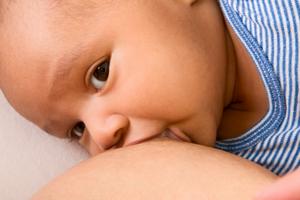
Breastfeeding is the natural way to feed your baby, but that does not mean that you will automatically know how to do it. Most mothers need advice and support especially during the first six weeks when everything is new.
Here are a few tips to help you breastfeed.
b. Make an informed decision about feeding your baby
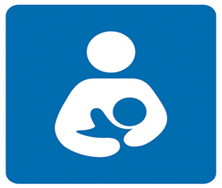 Deciding how you are going to feed your baby is one of the most important decisions you will make as a parent. Making an informed decision means you have all of the information you need to help you decide what is best for your family.
Deciding how you are going to feed your baby is one of the most important decisions you will make as a parent. Making an informed decision means you have all of the information you need to help you decide what is best for your family.
To make an informed decision about how to feed your baby you should know:
- The benefits of breastfeeding for the baby, mother, family and the community
- Good for Baby:
- Provides the best food that is always fresh and ready
- Helps to prevent constipation
- May increase protection against illnesses such as childhood diabetes
- Increases protection against ear, chest and stomach infections
- Increases protection against allergies if there is a family history of allergies
- May increase protection against Sudden Infant Death Syndrome (SIDS), also called crib death
- Helps to promote proper jaw and teeth development
- Good for Mom:
- Promotes closeness and touching with baby
- Helps the uterus to return to its normal size after birth
- Helps to control bleeding after birth
- Helps to protect against cancer of the breast and ovary
- Helps to keep bones strong
- Helps to use up the extra fat gained during pregnancy
- Saves money; formula is expensive
- Saves time; there is no need to prepare formula and bottles
- Does not produce any garbage; there are no formula and bottle packages to throw out
- Good for Baby:
- The health risks and costs of formula feeding
- Birth control compatible with breastfeeding
- Women have the right to be accommodated in the workplace during pregnancy and breastfeeding
- Once breastfeeding is stopped it is difficult to reverse the decision
Please  for more information on breastfeeding
for more information on breastfeeding
Risks of Formula Feeding
Babies are at increased risk of:
- Ear, chest and urinary tract infections
- Diarrhea
- Inflammation of the stomach and intestines
- Sudden Infant Death Syndrome(SIDS)
- Obesity
- Tooth decay
- Some childhood cancers
Mothers are at increased risk of:
- Postpartum bleeding
- Cancer of breast, ovaries and uterus
- Brittle bones
Others:
- Formula does not change to meet baby's growing needs
- Less convenient as extra time needed for sterilizing equipment and preparing formula
- Potential for mistakes to be made during formula preparation
- Potential for contamination during manufacturing and processing
If you have made an informed decision to feed your baby breast milk substitutes please contact your health care provider or your local Public Health office (www.gnb.ca/publichealth then click on Public Health Clinics).
| Ask for information on sterilization, preparation and storage or breast milk substitutes. |
c. Vitamin D
Breast milk provides all the nutrients your baby needs. In certain cases, supplements may be recommended.
Vitamin D is needed to develop healthy bones and teeth. Health Canada recommends giving a Vitamin D supplement to babies who are breastfed from birth. You should continue giving the supplement until such time that he or she gets enough Vitamin D in other foods or until the baby reaches one year old.
For more information about Vitamin D supplements, consult a health care professional - doctor, pharmacist, dietician, or nutritionist.
d. Sleep
To help lower the risk of Sudden Infant Death Syndrome (SIDS), a healthy baby should be placed on his/her back to sleep for every sleep. The safest place for a baby to sleep is in a crib, cradle, or bassinet that meets current Canadian regulations. Also, infants who share a room with a parent or caregiver for the first 6 months have a lower risk of SIDS.
Newborns snooze and sleep whenever they are tired. They have no real sense of being "awake" or "asleep". Each new baby establishes a pattern of sleeping and waking. As you get to learn your baby's patterns, you will know when he or she is sleeping, awake, and when in a quiet alert state.

You can help your baby learn the difference between sleeping and waking by putting the baby in their crib when he or she is very sleepy and interacting and communicating with your baby when he or she is awake. Babies will learn to associate their crib with sleep.
Here are a few tips to make the nights easier.
Babies who lie in one position for long periods can develop flat spots on their heads. This happens because the bones of the baby's skull are very soft in the first year of life. In addition, babies have weak neck muscles and have difficulty turning their heads on their own.
This is what you can do to prevent your baby from getting flat spots on his/her head.
e. Crying
All babies cry and many babies cry a lot. They cry because it is the only way they have to let you know that they need something.
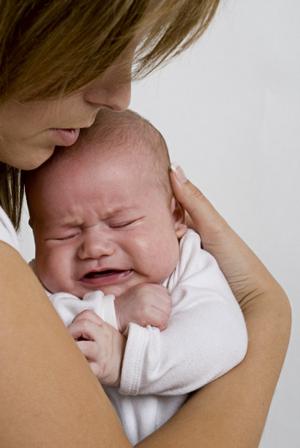
When your baby cries, try to find out why. With time, you will recognize your baby's different cries and know what to do.
Babies cry because they need food, love, attention, or cuddling. When you respond to crying, you are helping your baby learn that help and love come when needed. A baby whose needs are met will feel safe, secure, and loved, not spoiled.
The following table will help you identify the reasons why your baby cries and what to do.
Sometimes, no matter what you do, your baby will continue to cry. This can be very frustrating.
 |
Babies are very easily hurt if they are handled rougly or shaken. Shaking your baby can cause death or permanent brain damage. Make sure that everyone who handles your baby knows about ''Shaken Baby Syndrome''. |
It is easy to say ''stay calm'', but this can be very difficult to do. If you feel your temper rising and are afraid that you might hurt your baby, you should:
|
f. Colic
Colic is not an illness. A colicky baby cries a lot more than other babies. Nothing seems to comfort or stop them from crying. A colicky baby can be frustrating for parents. If you have a colicky baby, do not blame yourself because you are not responsible.

A baby with colic
- cries as if in pain after a feeding.
- pulls his knees up to his chest.
- may pass gas or vomit.
- cries for long periods no matter what you do.
Test Your Knowledge
|
|
The following exercise will help you learn a little more about colic and provide you with some coping techniques.
Click on the option button which corresponds to the correct answer and verify your answer by clicking on the "Check" button.
|
1 |
We do not know the cause of colic. |
|
2 |
Colic always occurs during the night. |
|
3 |
Colic begins at birth and disappears when the baby is two months old. |
|
4 |
Colic is often mistaken for crying related to other causes. |
|
5 |
If your baby has colic, you may need help. |
|
6 |
A calm atmosphere can help a baby with colic. |
|
7 |
Babies with colic should never be placed on their tummy. |
|
8 |
Noise and movement can sometimes help colicky babies. |
|
9 |
If you smoke, the nicotine is passed to the baby in the breast milk and can make the baby irritable. |
g. Bathing
Babies usually like to be warm, dry, and well wrapped. In the beginning, your baby may cry when given a bath. If this is the case, reassure your baby by talking softly. Handle your baby gently.
Most babies begin to enjoy their baths after a few months. Bath time becomes a fun time for the baby and the entire family.
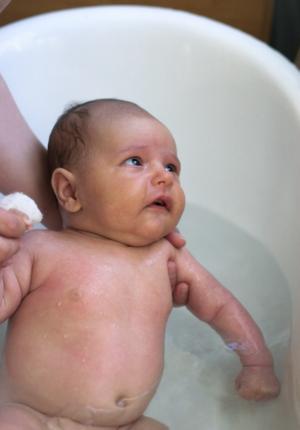
Babies don't need a bath every day, but you will need to keep their faces, hands, bottoms, and the creases in their necks, groin, and legs clean. It is not safe to clean inside the baby's ears or nose or to retract a baby boy's foreskin .
Here are a few bath time tips
Before you begin your baby's bath, be sure you have everything you need close at hand.
- a basin or tub - some parents use the kitchen sink
- mild unscented soap
- towels
- washcloths
- a soft baby hairbrush
- clean baby clothes and diaper
This is how to bathe your baby
h. Cradle Cap
i. Umbilical Cord Care
In the first two weeks, your baby's umbilical cord will dry up and fall off.
Keep the umbilical cord clean and dry.You will receive information on how to care for your baby's umbilical cord while you are in the hospital.
 |
See a doctor if:
|
Test Your Knowledge
The following exercise will help you learn a little more about the care of your baby's umbilical cord.
Click on the option button which corresponds to the correct answer and verify your answer by clicking on the "Check" button.
|
1 |
You can bathe your baby even though the umbilical cord has not fallen off. |
|
2 |
You must use alcohol to clean your baby's umbilical cord. |
|
3 |
It is important to keep the skin around the cord as clean and dry as possible. |
|
4 |
The area around the umbilical cord is sensitive for the baby. |
j. Bowel Movements
A baby's bowel movements change colour and texture over time. Bowel movements are different for breastfed and formula fed babies.
It is normal for babies to grunt and get red in the face when having a bowel movement.
In the first few weeks it is important to monitor the number of bowel movements your baby has to ensure they are getting enough milk. After the first few weeks, your baby may not have a bowel movement every day. This does not mean your baby is constipated. Babies are constipated when their bowel movements are hard and dry. If this happens, call your health care provider, public health nurse, or any health professional. A breastfed baby is rarely constipated because breastmilk contains enough water to keep the bowel movements soft.
When a baby's milk or food is changed, their bowel movements will generally change as well.
In the first few weeks, a well fed baby:
- at 1 day old has at least 1 wet diaper and at least 1 to 2 sticky dark green/black stools
- at 2 days old has at least 2 wet diapers and at least 1 to 2 sticky dark green/black stools.
- ** This is easier to notice urine in cloth diapers. A facial tissue can be placed inside disposable diapers, if you are not sure.
- at 3 days old has at least 3 heavy wet diapers and at least 3 brown/green/yellow stools. Occasional “red brick coloured” staining is normal until day 3.
- at four days old at least 4 heavy wet diapers and at least 3 brown/green/yellow stools.
- at 5 days and older, as the milk supply increases, baby has at least 6 heavy wet diapers and at least 3 large soft yellow seedy stools per day.
 |
Call your doctor if the baby's bowel movements are warety or have a strong smell. Your baby may have diarrhea. Diarrhea can make your baby very sick very quickly. |
k. Diaper Rash
Diaper rash is very common. It can range from a few red spots that are not serious to blisters and sores in more serious cases.
Diaper rash can be caused by a number of things.
To avoid diaper rash, change the baby's diaper often. Use a clean cloth to wash and dry the baby's bottom.
This is what to do if your baby gets a diaper rash.
l. Number of Wet Diapers
Baby's wet themselves between six to ten times a day (see bowel movement section). Changing your baby's diaper as soon as it is wet will help prevent diaper rash.
If your baby has fewer than six heavy wet diapers a day or if the urine is dark yellow and has a strong smell, it may mean that your baby needs more fluid. You should contact your health care provider if you baby does not have 6 heavy wet diapers a day.
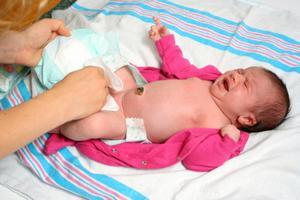
m. Check Ups and Immunization
Babies should be seen within the first 2 days if you leave the hospital within 48 hours after birth. If you stay more than 48hrs in the hospital after birth, your baby should be seen in the first week. Your health care provider will let you know how often your baby needs to be seen. During checkups, babies are weighed and measured. Their development is also checked.
Immunizations are also part of regular health care. To view the schedule of your baby's immunizations please visit the following website:
http://www2.gnb.ca/content/dam/gnb/Departments/h-s/pdf/en/CDC/Immunizati...
In addition to the immunizations they receive as babies, children need booster shots between the age of four and six, before starting school. Talk with your health care provider or public health nurse for more information about checkups and immunizations.
